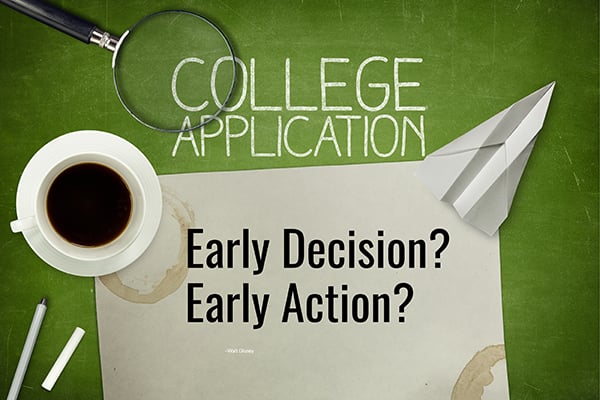Physical Address
Early decision (ED) applications are binding, meaning students who apply via early decision must enroll in the school if they are accepted. This is the key difference between early decision and early action, which is nonbinding.
Should You Apply Early Action vs Early Decision?
You’ve put together your list of dream, match, and safety schools, and there’s one on there that makes your heart beat a little faster. Should you prove your love by applying early?

Many colleges allow applicants to submit their materials for an early deadline (sometime in the fall) that falls before the regular deadline (usually sometime in January or February). Here’s what you need to know.
Advantages of applying early
Show You’re Serious
Applying early lets your favorite school (or schools) know that you are serious about attending. Schools track how many applicants accept their offers of admission and release those numbers to the public. A school looks good when a high percentage of accepted applicants chose to attend. So if they think you’re likely to accept their offer of admission, it may give your application a leg up.
Cut Down on Admission Stress
If you are accepted to your dream school, you won’t have to bother with the time and expense of applying elsewhere. You can put your focus back on right now instead of one year from now.
Some students and high school counselors believe that applying early decision gives them better odds of acceptance, but the truth is early acceptance rates and admissions standards vary from school to school. You can find early decision application numbers and acceptance rates for many schools in our Best Colleges book, and don’t be afraid to ask an admission counselor at your dream school directly about their early admission practices.
There is a (potential) disadvantage to applying early, however. You may not have the opportunity to compare financial aid packages offered by other schools.
Read More: Search for Colleges
Early Action vs Early Decision
Most schools allow you to apply early in one of two ways: early decision or early action.
Early decision
Early decision is binding. This means if you are accepted through early decision, you are committed to attending that school, and will withdraw any applications you may have submitted for the regular deadlines at other schools. You may not apply to more than one college under early decision. If you are not accepted, you will either be rejected or deferred. Rejected applicants may not apply again that year. Deferred applicants will be reconsidered during the regular admission period, and are free to apply to other schools.
Early decision deadlines are often in November, and students are typically notified of the decision in December.
Early action
Early action is non–binding. This means you are not bound to attend if you are accepted. You may also apply early action to multiple colleges. Early action deadlines usually fall at the same time as early decision.
The obvious advantage of early action over early decision is the opportunity it gives you to apply to, and ultimately compare financial aid packages from several schools. If you are accepted early decision, you risk missing the admission deadlines of other schools while you wait for your award package to arrive. If that award is lackluster, your options are fewer.
Our Advice
If you’re sure that you’ve found your best-fit school, you know it’s one you want to attend, you’re a strong candidate for admission, and you know that you can afford the tuition, go ahead and apply early decision.
That is a whole lot of research and comparison to have done by fall of your senior year, though, and if you’re uncertain about any of those factors, you’re not alone! Keep your options open by applying early action, or by the regular deadline.
Looking for strategic college advice?
Get one-on-one help from former Ivy League and top tier admission officers. Our College Counselors will help you find, apply, and get accepted to your dream school.
Read More
About Rob Franek
Rob Franek, Editor-in-Chief at The Princeton Review, is the company’s primary authority on higher education. Over his 26-year career, he has served as a college admissions administrator, test prep teacher, author, publisher, and lecturer. Read more and follow Rob on Twitter: @RobFranek.
What is the Difference Between Early Decision and Early Action?

“Early decision” and “early action” college applications allow students to do exactly what the names of the applications suggest. Students submit the early applications before “regular decision” applicants and learn whether they are accepted well before the pool of regular decision applicants.
College applications may be stressful and time-consuming, and many students are anxious to get them out of the way so they can enjoy the rest of their senior year. However, before students hit “submit,” it’s important to clarify the difference between early decision and early action applications and consider carefully whether applying to college early is best for their individual circumstances.
Early Decision vs. Early Action Applications
A student who is a great fit for early action may not be the right candidate for early decision, so students should read the descriptions below carefully.
Early Decision Applications
Early decision (ED) applications are binding, meaning students who apply via early decision must enroll in the school if they are accepted. This is the key difference between early decision and early action, which is nonbinding.
Key things to understand about ED applications:
- Students can only apply for ED to one
- While students can apply via “regular decision” applications to other schools, they must withdraw their applications to those schools if they are accepted to the school where they applied for ED and plan to attend.
- Because an ED application is binding, colleges typically require ED applicants to have a form signed by a parent and a school counselor stating the student understands the application is binding, and the student agrees to enroll if accepted.
- ED applications are typically due in November. Students should check the deadline with their school of choice, as this might vary.
- ED applicants typically receive admissions decisions in December.
Early Action Applications
Like ED, Early action (EA) applicants find out whether they’re accepted to schools earlier than regular decision applicants.
The key difference is that EA applications are nonbinding, meaning students who are accepted via EA are not obligated to enroll in the college. This allows applicants to wait for admissions responses from other schools and compare their options.
Key things to understand about EA applications:
- Unlike ED, students can typically apply for EA to multiple schools.
- EA is nonbinding. Unlike ED, they are not obligated to attend the school.
- Like ED applications, EA applications are typically due in November. Students should check the deadlines for each school.
- EA applicants typically receive admissions decisions from colleges in December or January.
- Unlike ED, EA applicants typically have until May 1, known as National Decision Day, to formally commit to their college of choice.
Which Students Should Apply Early?
After researching the difference between early decision and early action applications, students need to decide whether applying for early acceptance is right for them.
Students should only apply for early decision applications if:
- They thoroughly researched colleges. They should have chosen one top-choice college since ED applications are binding.
- They understand they won’t get to compare financial aid packages offered by other schools. They’re comfortable committing to the school, knowing a different college may be more or less affordable.
- They’re high-performing students. Their test scores, GPA, and class rank meet or exceed the minimum admissions requirements detailed on the college’s website.
- They can adequately complete application requirements before the November deadline. Students need to give themselves ample time to respond to college essay prompts thoughtfully and give letter writers plenty of time to complete letters of recommendation. Rushing through the process to meet the ED deadline may lead to mistakes that hurt students’ chances of being accepted.
- They’re content with their class rank and GPA as of the end of their junior year. Some students prefer to work hard during the fall semester of senior to improve their academic standing and submit regular decision applications during their second semester.
Students are a good fit for early action applications if:
- They can adequately complete application requirements before the November deadline. Students should make sure to review essays carefully and give letter writers plenty of time to complete letters of recommendation. Rushing through the process to meet the EA deadline may lead to mistakes that hurt students’ chances of being accepted.
- They’re content with their class rank and GPA as of the end of their junior year. Some students prefer to work hard during the fall semester to improve their academic standing and submit regular decision applications during their final semester of high school.
CFNC Helps Students Keep their Applications Organized
Whether students decide to apply to college early or join the regular pool of applicants, the College Foundation of North Carolina can help them meet important deadlines and keep their applications organized.
Use the CFNC Application Hub to apply to North Carolina colleges, send official high school transcripts, and monitor progress in a single place.









